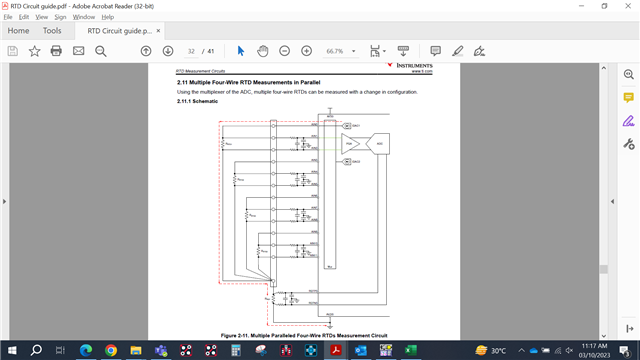
In above image, can we use high side reference for RTD measurement instead of low side connection?
This thread has been locked.
If you have a related question, please click the "Ask a related question" button in the top right corner. The newly created question will be automatically linked to this question.
Hi Neel Shah,
The high-side reference is most advantageous when using a 3-wire RTD. It is certainly possible to use a high-side reference, but then you will also need to add a biasing resistor to ensure that the RTD inputs are in the correct input range for the PGA. This may limit the range of the RTD measurement depending on the magnitude of the IDAC current and the values of the resistances involved to maintain IDAC compliance.
The low-side reference removes the need to add an additional bias resistor as the reference resistor will place the RTD within the correct input range for the PGA. Is there are particular reason why you want to use the high-side reference?
Best regards,
Bob B
Hi Neel Shah,
A colleague also reminded me that you would require an external mux when making the reference high-side to direct the output current to the desired RTD being measured. This is all doable, but complicates the design more then needed.
Best regards,
Bob B
Hi Neel Shah,
Can you help us understand you want from us? Bob already explained the challenges with trying to measure multiple RTDs and a high-side reference. It is certainly possible, but it is more complicated than simply using a low-side reference configuration.
So what do you mean when you ask "is it ok to use in 4-wire high side connection"?
-Bryan
Hi Neel Shah,
Previously, Bob provided you with the following guidelines:
It is certainly possible to use a high-side reference, but then you will also need to add a biasing resistor to ensure that the RTD inputs are in the correct input range for the PGA. This may limit the range of the RTD measurement depending on the magnitude of the IDAC current and the values of the resistances involved to maintain IDAC compliance.
A colleague also reminded me that you would require an external mux when making the reference high-side to direct the output current to the desired RTD being measured. This is all doable, but complicates the design more then needed.
Does this not answer your question: "In above reference can we use high side connection for two PT100 4 wire connection?"
You can also reference our Precision Labs videos covering RTD measurements for more information: https://www.ti.com/video/series/precision-labs/ti-precision-labs-analog-to-digital-converters-adcs.html. These videos are at the bottom on the right side of that page ("Measuring RTDs with precision ADCs")
Specifically, see the videos titled "Measuring multiple RTDs with a multiplexed ADC and intro to conversion latency" as well as "Designing software versus hardware configurable multi-RTD measurement systems". Both of these videos delve into the details of how to design a system that measures multiple RTDs
-Bryan
Hi Bryan,
Hi Neel Shah,
Bob mentioned that using a high-side reference is "most advantageous when measuring 3-wire RTDs". In other words, there is no benefit to using a high-side reference with 4-wire RTDs. In fact, using a high-side reference actually makes the system for measuring a 4-wire RTD more complex, as we have described to you already.
So we questioned why you needed to use a high-side reference for 4-wire RTDs, because this will make your design more complex and offer no benefit in return. Our recommendation would be to use a low-side reference when you are measuring 4-wire RTDs.
-Bryan